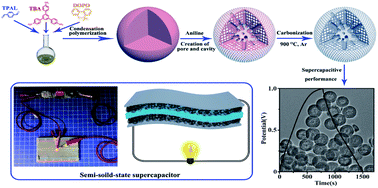A selective etching approach to pore structure control of polymeric precursors: creating hierarchical porous N, P co-doped carbon nanospheres for semi-solid-state supercapacitors†
Abstract
In this work, utilizing a dynamic imine exchange, we develop a selective etching strategy to construct porous polymer nanosphere precursors, which can be subsequently carbonized into hierarchical porous carbon nanospheres (PCNPs) co-doped with both N and P elements. Our strategy to construct polymer precursors is simple, suitable to various aldehyde and amino building blocks and easy to incorporate heteroatoms into the carbon matrix. Importantly, by simply adjusting the concentration of the etching agent, PCNPs with micro- and meso-pores or even hollow structures can be controllably fabricated. The as-prepared PCNPs exhibit excellent electrochemical performance with the highest specific capacitances of 359.5 F g−1 at 0.5 A g−1 and 224.0 F g−1 at 20 A g−1 under acidic conditions (1 M H2SO4). The cycling stability of the PCNPs is also attractive, with a capacitance retention of ∼95% after 5000 cycles. Semi-solid-state supercapacitors assembled using PCNPs as electrodes and H2SO4/PVA as a gel electrolyte exhibit specific capacitances up to 226.7 F g−1 at 0.2 A g−1 and 126.0 F g−1 at 20 A g−1.



 Please wait while we load your content...
Please wait while we load your content...